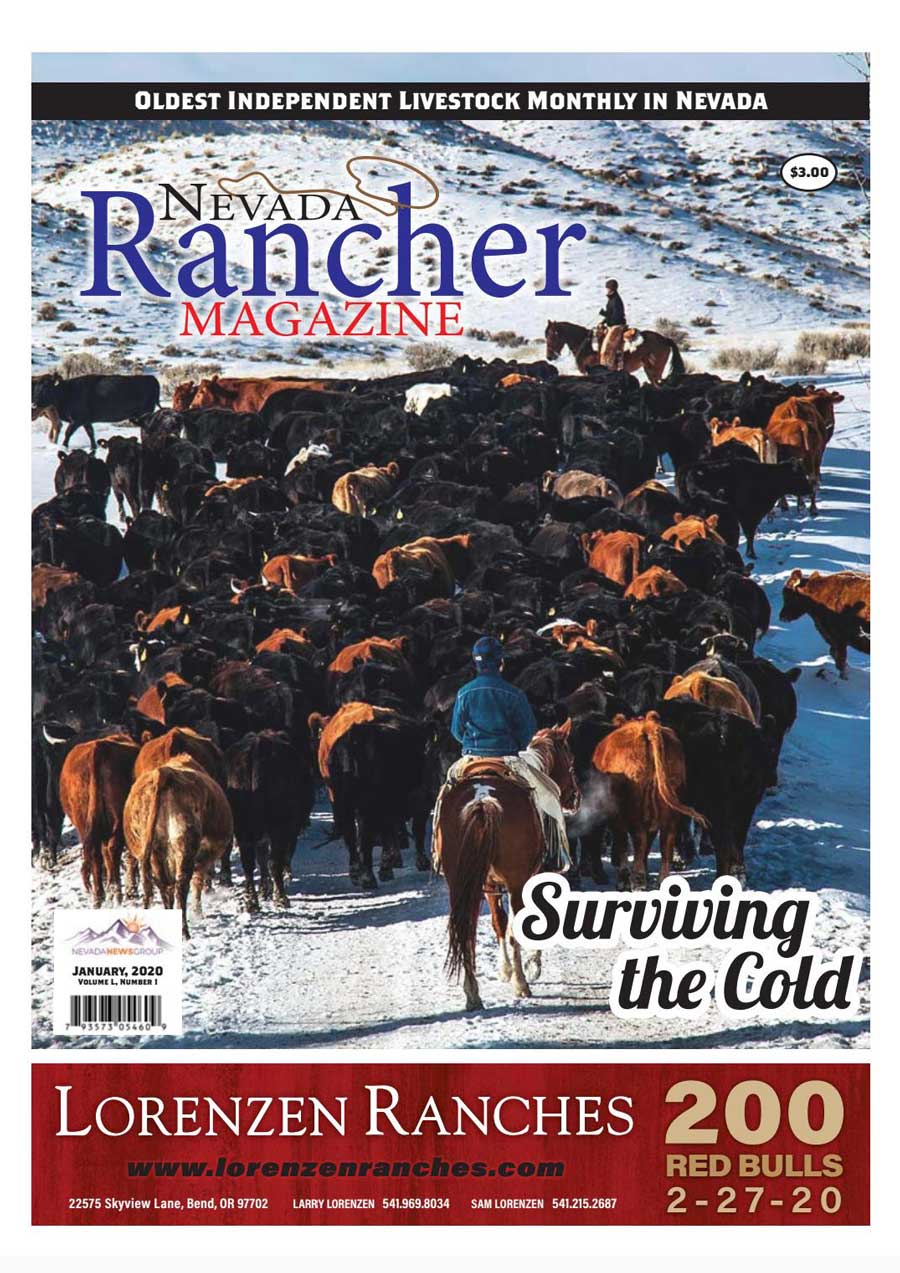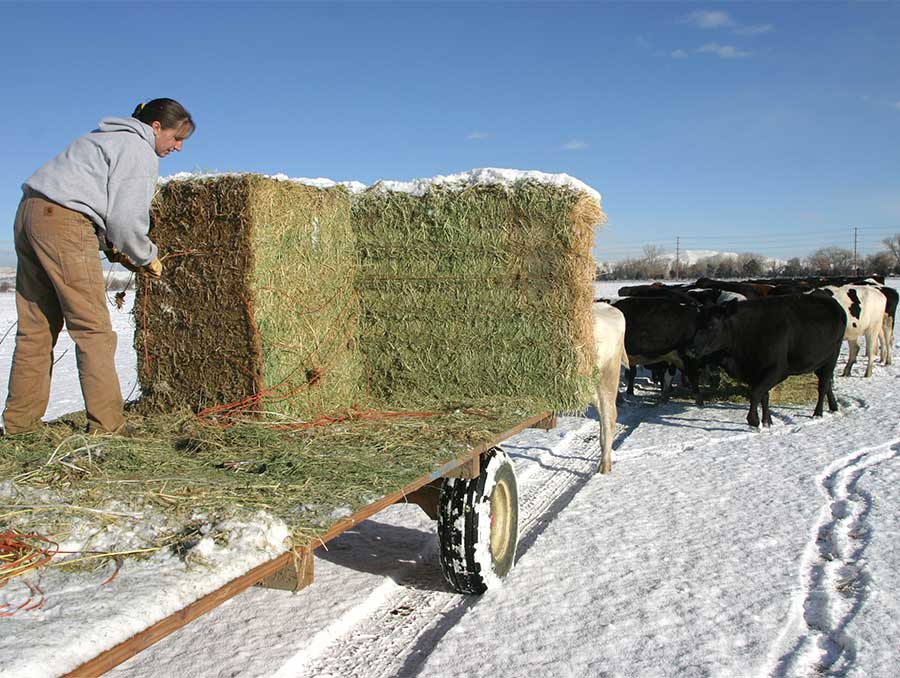Having adequate supplies of high-quality water for livestock is essential for successful livestock operations. This can be a real challenge during the winter months, especially for ranchers who utilize watering sources that have no electricity available. Read the Nevada Rancher Magazine Article below to explore several ways ranchers can overcome this challenge.

Cattle need daily access to water to meet their needs during winter months, although the total amount consumed decreases compared to warmer weather conditions. Water intake by beef cattle is quite constant up to 40°F.
In colder weather, cattle need to consume more feed to meet energy needs. For every one pound of dry matter consumed, cattle need to drink about seven pounds of water to maintain desired levels of dry matter intake.
Animal performance suffers because feed intake is suppressed when adequate access to good quality water is not available to meet their needs. As a result, feedlot gains, lactation levels and calf growth rates are reduced and farm production goals will be impacted.
Some producers have questioned the need for a year round water supply, since snow is usually available during winter months. Limited research has been conducted on use of snow as a sole water source for out-wintered cattle. Canadian researchers reported that mature cows in adequate body condition (score 5 or higher) can maintain themselves and their calves with snow as the only water resource. However, another study reported that weaned calves (450-600 pounds) had lower average daily gains (- 0.2 lbs) and reduced feed efficiency compared to calves with access to water.
The Canadian researchers also observed that eating snow is a learned behavior, and cattle preferred, clean, loose snow that they can easily scoop up with a sweeping motion using their tongue, much as they graze forages. Dirty snow, ice, crusted snow or even dry, fluffy snow conditions may prevent adequate water intake. Restlessness, bellowing, and interruption of regular eating patterns were observed in animals that were not meeting their water requirements due to poor snow quality and availability.
Thus, while snow may be considered an emergency water source during winters, good animal husbandry practices should include ensuring access to water to prevent winter dehydration and maintain desired animal performance.
There are several designs of winter watering systems that help deliver water to livestock during cold and windy winters. The most common problem with a watering system in cold weather is freezing due to heat loss. Reducing heat loss from a watering system can improve efficiency by decreasing the amount of energy used.
The first step is to limit the exposure of the water tank to open air and wind. The proper placement of the tank is important. Water tanks need to be protected from the wind where possible. The most common method is running a waterline below frost line underground. This prevents freezing of the line and allows warm air into the standpipe from the earth.
A standpipe connects the waterline to the tank. Ensure there is a good seal between the tank, concrete base pad and standpipe. This will prevent cold air from entering into the standpipe. For additional protection, use flexible foam insulation around the vertical supply line. This type of insulation protects the pipe down to -40 F.
Typically, there is a shutoff valve where the waterline begins to run vertical. In addition, there should be a way to drain the vertical line when not in use.
Within the tank's housing, a float valve regulates water flow; this will eliminate the need to monitor the tank during filling.
Other options Include:
- Pump water into a large enclosed storage tank at a higher elevation. You should insulate the tank in some way, bury it or mound dirt around it. If the tank is exposed, paint it black to absorb the sun's heat during the day. From the storage tank, run a buried line to supply the watering tanks by gravity and control this flow with a float valve. You may want to use a thermostatically controlled float valve that opens when temperatures drop below a certain point. You can position some of these valves to direct water around the outside of the watering tank to keep water open for stock. You can also pump water into the storage tank during the day so that it will continuously trickle into the watering tank at night and on cloudy days. The watering tank will need an overflow drain-field.
- If a storage tank is not an option, you can use a solar pumping system to fill the watering tank directly during the day. Make a small hole that allows the tank to drain slowly at night to keep water moving.
- You can use large heavy equipment tires as watering tanks. These help keep water open since they are black and absorb heat from the sun. They are also flexible enough not to crack if freezing occurs. These tires are often free and are very tough and can take abuse from animals.
- Much of the heat loss from a watering tank occurs at the surface of the water. You can reduce the heat loss considerably by placing an insulated cover over a large part of the surface area of the tank. Provide openings around the edge where animals can drink. You can also insulate the sides of watering tanks with insulation material, sawdust or wood chips. Partially burying a watering tank, or berming it with earth, takes advantage of the ground's warmth to prevent freezing.
- Another way to make use of underground warmth is to install a culvert with a sealed bottom under the tank. You can circulate water from the culvert into the tank with a separate low-wattage solar-powered pump. This system requires a battery bank to allow for night use. You will need to put the batteries in a non-freezing area, perhaps on a platform above the water level in the culvert.
- You can use a special in-tank propane heater to keep water from freezing.
- Innovative producers have experimented with building solar-heated air or water collectors on their tanks. A system such as this uses the sun's heat to keep the tank from freezing.
- Another way to use propane is to run a quarter-inch copper tube from the regulator into the water tank and crack the propane valve open slightly, just enough to allow small bubbles to flow from the tube. The bubbling action will keep water open at the spot it emerges from the tube. A propane tank will last over a month if used in this manner. The livestock waterer can he placed in a location where the propane can be easily dispersed by the wind to prevent an accumulation of propane gas. A propane bubbler can be constructed for about $90 from materials acquired at a hardware store. If you have an old propane bottle, you can have it filled and save about half of the cost.
Steve Foster is an associate professor and Extension educator with University of Nevada, Reno Extension's Pershing County Office. A certified crop advisor and experienced livestock producer, Foster has expertise in the fields of agriculture, natural resources and youth development.












